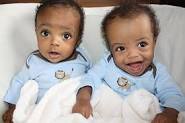Unless you are a twin, have had twins, or are close to a pair of them, you probably don’t know much about them. We all know they look alike, their parents dress them the same…but that’s about all. You may have wished for an identical twin on many occasions; one you could trade responsibilities with, like classes at school or swapping jobs. But there is a lot more to twins than just what you see.
1. Twins can have different biological fathers.
Each month, a woman releases one egg that can be fertilized by one sperm. However, there are times when two eggs are released, both of which could potentially be fertilized by separate male donors.
2. Twins can be different races.
If the parents of twins are mixed races, their eggs and sperm both contain the genetic potential for multiple skin types. There are millions of possible outcomes for both babies, and in rare cases – both twins could be of a unique race.
3. Separated twins have been known to live very similar lives.
There are multiple stories circulating of twins who (for whatever reason) were separated at birth and lived lives that eerily mirror the other’s. Sometimes their similarities go beyond coincidental, such as marrying a woman with the same name, naming children the same thing, taking the same professions, and even falling ill at the same time.
4. If identical male twins have children with identical female twins, their children will legally be classified as cousins – but genetically they will be full siblings.
5. Since the genetic pool of identical twins is (not surprisingly) identical, if two sets of identical twins have children, those children have the same genetic makeup as their cousins.
6. Taller women have a higher chance of giving birth to twins.
Countries with a taller-than-average ratio of women also have higher rates of births to twins. Taller people have higher levels of growth hormones, and in women this makes their ovaries more susceptible to spontaneous twinning.
7. Dairy products are also more likely to have twins.
Women who consume animal products, specifically dairy, are five times more likely to have twins.
8. Twins show signs of their bond in the womb.
According to an Italian study, twins begin reaching for the other as early as 14 weeks. By the 18th week, they touch the other twin more than themselves. Interestingly, the twins also gestured with and were delicate with each other.
9. Twins can be exact reflections of the other and are called Mirror Twins.
About 1/4 of identical twins wind up facing each other in the womb, and they become reflections of the other. One will be right-handed where the other is a lefty, and birthmarks will appear on opposite sides of the body.
10. It is possible for some conjoined twins to see through the other’s eyes and hear each other’s thoughts.
Some twins who are joined at the head share a thalamus. The thalamus is the part of the brain that controls physical sensations and motor functions. As a result, these twins can see through the eyes of, hear the thoughts of, and feel the sensations of the other twin.
11. A woman’s body can adapt to twins.
If a mother is breast feeding her twins, her breasts can individually adjust their temperature to regulate the comfort of each twin.
12. The belly button is the easiest way to tell twins apart.
Belly buttons are not genetic, they are scars left from removing the umbilical cord. Each one is slightly unique.
13. If a woman is a fraternal twin, she is more likely to give birth to a set herself. She is also much more likely to give birth to twins if she already has, or if she has siblings who are twins.
14. Even identical twins do not have identical fingerprints.
Even though they have identical DNA, fingerprints are formed by babies touching the amniotic sac, whose unique forms and ridges leave us with our individual fingerprints.
15. Twins are twice as likely to be left-handed than individually born people.
16. Twins can be born months apart.
Due to complications such as the water breaking prematurely, twins can sometimes be born weeks to months apart. The record for time between births of twins is thought to be 87 days, nearly 3 months.
17. Identical twins could grow up to be the perfect criminals.
Because they can share up to 99.9% of the same DNA, forensic experts would have a hard time pinning the crime on a specific twin if each of them had alibis and denied a crime. This means both would walk free.
Credit : Comet.














